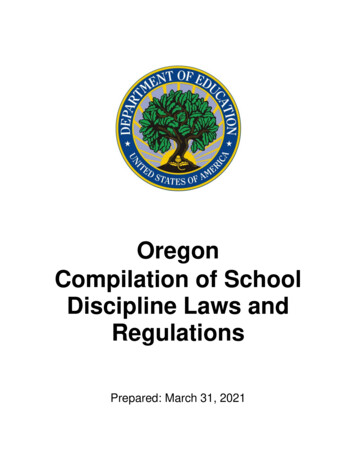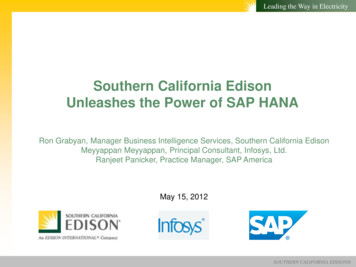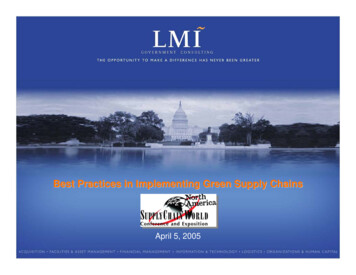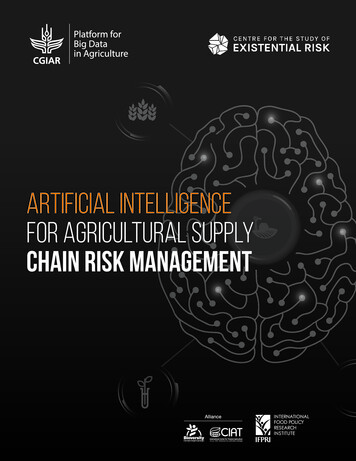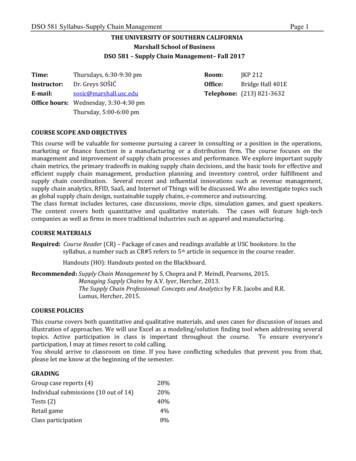
Transcription
DSO 581 Syllabus-Supply Chain ManagementPage 1THE UNIVERSITY OF SOUTHERN CALIFORNIAMarshall School of BusinessDSO 581 – Supply Chain Management– Fall 2017Time:Instructor:E-mail:Office hours:Room:JKP 212Office:Bridge Hall 401ETelephone: (213) 821-3632Thursdays, 6:30-9:30 pmDr. Greys SOŠIĆsosic@marshall.usc.eduWednesday, 3:30-4:30 pmThursday, 5:00-6:00 pmCOURSE SCOPE AND OBJECTIVESThis course will be valuable for someone pursuing a career in consulting or a position in the operations,marketing or finance function in a manufacturing or a distribution firm. The course focuses on themanagement and improvement of supply chain processes and performance. We explore important supplychain metrics, the primary tradeoffs in making supply chain decisions, and the basic tools for effective andefficient supply chain management, production planning and inventory control, order fulfillment andsupply chain coordination. Several recent and influential innovations such as revenue management,supply chain analytics, RFID, SaaS, and Internet of Things will be discussed. We also investigate topics suchas global supply chain design, sustainable supply chains, e-commerce and outsourcing.The class format includes lectures, case discussions, movie clips, simulation games, and guest speakers.The content covers both quantitative and qualitative materials. The cases will feature high-techcompanies as well as firms in more traditional industries such as apparel and manufacturing.COURSE MATERIALSRequired: Course Reader (CR) – Package of cases and readings available at USC bookstore. In thesyllabus, a number such as CR#5 refers to 5 th article in sequence in the course reader.Handouts (HO): Handouts posted on the Blackboard.Recommended: Supply Chain Management by S. Chopra and P. Meindl, Pearsons, 2015.Managing Supply Chains by A.V. Iyer, Hercher, 2013.The Supply Chain Professional: Concepts and Analytics by F.R. Jacobs and R.R.Lumus, Hercher, 2015.COURSE POLICIESThis course covers both quantitative and qualitative materials, and uses cases for discussion of issues andillustration of approaches. We will use Excel as a modeling/solution finding tool when addressing severaltopics. Active participation in class is important throughout the course. To ensure everyone’sparticipation, I may at times resort to cold calling.You should arrive to classroom on time. If you have conflicting schedules that prevent you from that,please let me know at the beginning of the semester.GRADINGGroup case reports (4)Individual submissions (10 out of 14)Tests (2)Retail gameClass participation28%20%40%4%8%
DSO 581 Syllabus-Supply Chain ManagementPage 2GROUP CASE REPORTSPlease form teams of up to four persons within the first two weeks; you will be working in theseteams for the group assignments. Use the “Group” option on the Blackboard to join one of the teams.The cases are to be discussed within your team and you will submit (as a team) a written report. ThisSyllabus provides some suggested questions that you should address in your analysis. Each team isrequired to submit a written report on four case studies (Genentech on 9/14, Three Jays on 10/12, Plazaon 11/19, and Han Solar on 11/30). Case write-ups should be at most 4 pages and single-spaced (11 or 12point font), with appendices attached (not included in the number of pages). They should be submitted online through the Blackboard, along with the Excel files used in your analysis. You will also need to entersome of the main results of your analysis separately on the ForClass, following the link on the Blackboard.When preparing your report, imagine that you, as a consultant, have to study an organization, to identifythe main issues it faces, and to propose a set of recommendations. Your written report should begin withan executive summary, about half page long, summarizing the most important problems and yourrecommendations (something a busy executive would read and understand what the report is about). Therest of the report should be organized as follows:1. Brief description of the company and its environment2. Brief description of the problems and issues to be addressed (the questions in the syllabus relatedto the specific case should guide you in identifying those issues).3. Recommendations and implementation plan.4. Analysis that discusses why the recommendations will solve the problems identified.You may choose to organize the report differently; however, please ensure that the above aspects arecovered and the report is well organized with clear section and sub-section headers. Please avoidrepetition of case facts and long expositions (remember the page limit)! Consider what you believe are themost important factors (and why). General solutions to specific problems will get you little credit. Bothquantitative and qualitative analysis is important. Creativity in analysis and suggestions that are groundedin case facts will be given high credit. Please state any assumptions made clearly. Remember that yourmodels are usually based on the forecasted demand and that different parameters and costs in the modelsare estimated (forecasted), so it is useful to provide some what-if analysis that considers, e.g., differentpossible demand scenarios, changes in cost estimates, etc.GROUP ASSIGNMENT EVALUATIONTeam assignments provide a valuable learning experience – how to work effectively and efficiently ingroups, learning from others, and honing your ability to communicate to others. Although your team’s gradedepends on each member’s efforts, some students can be tempted to let others carry their load. In order toprovide an incentive for all students to make maximum contributions to the study group, you will be askedto grade each team member’s contributions. Your group grades will be adjusted to obtain an individualgrade based on performance feedback provided by other members of the group (the group assessmentforms are posted on the Blackboard). If you do not submit your group assessment form, I will assume thatyou gave a rating of 100% to all your group members. The forms can be submitted in person or via e-mail,but no later than the exam date.INDIVIDUAL (SHORT) SUBMISSIONSIn addition to the cases for which you are required to submit group reports, we will be discussing othercases and articles. You should be prepared for class discussion, and this Syllabus provides somesuggested questions that you should address. For the individual submissions, follow the link on theBlackboard and enter the required information before the class on the ForClass website. Your grades forindividual submissions will be posted on the ForClass website. The objective of this short submission isto ensure that you prepare the case. For that reason, no late submissions will be accepted.
DSO 581 Syllabus-Supply Chain ManagementPage 3To answer short submissions #7 and #8, you can use Excel and submit the files along with your answers.The credit will depend on correctness of your solution. For the remaining submissions, as long as youranswer shows that you have given sufficient thought to the analysis, you will get full credit. Note thatthis in general requires answers that are longer than one sentence.Each submission is worth up to 2 points, and the maximum number of points you can obtain forindividual submissions is 20. If your total exceeds 20 points, it can improve your participation grade(note that in this case, each additional submission does not increase your participation by 2 points).We will do a simulation game during week 10. As a preparation for this exercise, you need to read therelevant material posted on the Blackboard (Retail game case and instructions), analyze the spreadsheetwith historical data, and use them to determine your order quantity for the two products. Thesequantities should be entered following the link provided on the Blackboard, along with a briefexplanation of how these numbers were selected. You can obtain up to 4 points for a thoughtful analysisand quantity choice.TESTThere will be two exams, and they will contain both qualitative and quantitative questions. The questionswill have several formats: multiple choice/single answer, multiple choice/multiple answers, shortanswers, and problems. The exams will be closed book; however, you can prepare a “cheat-sheet” for bothexams: for each exam, you can prepare one letter-sized sheet of paper hand-written on both sides (for atotal of 2 hand-written pages). I will remove all printed or photocopied material!According to the USC Final Exam Schedule, the final exam is scheduled for December 7, at 7 pm. If thereare extenuating circumstances that prevent you from taking an exam, you must discuss the reason with mebefore the time of the exam. You will not be given a make-up exam unless you obtain a permission fromme in advance. In addition, you must be able to document the extenuating circumstance. If you miss theexam due to a medical emergency that can be documented and verified, then a make-up exam will begiven. Otherwise, a grade of zero will be given for the missed exam. Note that a make-up exam cannot betaken before the actual exam date!CLASS PARTICIPATIONClass participation requires that you do the assigned readings, analyze the cases based on the questionsgiven and participate actively in class. I prefer substantive comments based on good analysis rather thanbrief, general comments that add little to the discussion and learning. Be prepared to defend yoursuggestions or solutions!If you are reluctant to talk in class or if you are not physically attending, but would like to show yourpreparation, please provide me with your analysis/comments through email. This may include materialrelated to the topics covered in class from your work experience, from additional articles/videos that youhave found, etc. I also encourage you to participate in the Discussion board on the Blackboard; it will beconsidered as a part of your participation.As a part of the participation I will also track your attendance through Arkaive app. Please download theApp to your smartphone and enable location, enter enrolment code H5F0 and check into class eachweek.GETTING HELPIf you have questions about any aspect of the course, you can always talk to me. If it is a quick question,you can contact me before or after the class, or during the break. If you need more time or privacy, you cancome to my office hours. If you cannot make my office hours, you can contact me and we can arrange for analternative time. The best way to reach me is by e-mail.
DSO 581 Syllabus-Supply Chain ManagementPage 4GRADINGGraded work will be posted on the Blackboard and ForClass. Disputes over graded material should bebrought to my attention as soon as possible.NOTICE ON ACADEMIC INTEGRITYThe use of unauthorized material, communication with fellow students during an examination,attempting to benefit from the work of another student, and similar behavior that defeats the intent ofan examination or other class work is unacceptable to the University. It is often difficult to distinguishbetween a culpable act and inadvertent behavior resulting from the nervous tensions accompanyingexaminations. Where a clear violation has occurred, however, the instructor may disqualify the student'swork as unacceptable and assign a failing mark on the paper.Academic dishonesty includes: (Faculty Handbook, 1994: 21-22): Examination behavior - any use of external assistance during an examination shall be consideredacademically dishonest unless expressly permitted by the teacher. Plagiarism - the appropriation and subsequent passing off of another’s ideas or words as one’sown. If the words or ideas of another are used, acknowledgment of the original source must bemade through recognized referencing practices. Other types of academic dishonesty - submitting a paper written by or obtained from another,using a paper in more than one class without the teacher’s express permission, obtaining a copy ofan examination in advance without the knowledge and consent of the teacher, changing academicrecords outside of normal procedures and/or petitions, using another person to completehomework assignments without the knowledge or consent of the teacher.FOR STUDENTS WITH DISABILILITIESAny student requesting academic accommodations based on a disability is required to register withDisability Services and Programs (DSP) each semester. A letter of verification for approvedaccommodations can be obtained from DSP. Please be sure the letter is delivered to me as early in thesemester as possible. DSP is located in STU 301 and is open 8:30 a.m. - 5:00 p.m., Monday throughFriday. The phone number for DSP is (213) 740-0776.STATEMENT ON TECHNOLOGY USEPlease note that communication devices such as cell phones, smart phones, tablets, etc. capable of sendingand/or receiving electronic communication and all entertainment devices are to be turned off and kept offthroughout the class session. Receiving or sending communication or entertainment during class disruptsthe learning environment and is rude to those around you.
DSO 581 SyllabusPage 5Date8/24TopicIntroduction to Supply ChainManagementReadingsThe Seven Principles of Supply ChainManagement (CR#1)Submission128/31Supply chain strategyDesign for supply chain managementApple (CR#2)39/7Design for supply chain managementDemand forecastingWorld Co. (CR #3)short #1 – Apple (q.#1)short #2 –Mass customization (p.6,under Week 2, q.#2)short #3– World Co (q.#3)49/14Demand forecastingCapacity planningNote on forecasting (CR#4)Genentech (CR #5)Group #1 - Genentech59/21Aggregate planningSourcing decisionsAggregate planning (CR #6)Cisco (CR #7)short #4 – Cisco (q.#4)69/28Supply chain disruptions (CR #8)short #5 – Disruptions (q.#1)710/5810/12Sourcing decisionsInventory management – Economiesof scaleInventory management –UncertaintyMIDTERM (Weeks 1-6)Inventory management –UncertaintyNote on Inventory Models (CR#9)Inventory-driven costs (CR#10)Three Jays (CR#11)910/19Inventory management – Productavailability1010/261111/2Supply chain alignment andcoordinationRevenue managementLogisticsshort #6 – Inventory-driven cost(q.#1)Group #2 –Three Jaysshort #7 – Cycle inventory (p.8, underWeek 9, q.#1-2)short #8 – Inventory centralization(p.9, under Week 9, q.#1,2)Retail game analysis1211/9Guest speaker from Good FoodHoldingsNetwork design in supply chains1311/16Facility locationIT in supply chains1411/23Thanksgiving Day – no classes1511/30IT in supply chainsSustainability in supply chainsFINAL EXAM12/7Note on the "Retail inventory andpricing game" (HO)Staple yourself to an order (CR #12)Yummy77 (CR #13)Reverse Logistic Program Design(CR#14)Plaza (CR#15)short #9 – Staple yourself (q.#2)short #10 – Reverse logistics (q.#2)short #11 – Yummy77 (q.#3)Intel (CR#16)SAP (CR#17)short #12 –Intel (q.#2)short #13–SAP (q.#3)Supply chain analytics (CR #19)Han Solar (CR#18)Short #14-SC analytics (q.#2)Group #4-Han SolarGroup #3 – Plaza
DSO 581 SyllabusPage 6Detailed course planWeek 1Introduction to Supply Chain Management and Key Supply Chain ConceptsReadings: The Seven Principles of Supply Chain Management, D.L. Anderson, F.F. Britt, D.J. Favre, Supply chainmanagement review, 1997Week 2Supply chain strategy; Design for supply chain managementCase study: (Ivey case #W14161): Apple Inc.: Managing a Global Supply ChainDiscussion Questions:1. Review Apple’s supply chain for its iPhone. What differences set it apart from competitors?2. What are Apple’s key advantages in how it manages its supply chain operations? Support youranalysis with the data from the case.3. What are the challenges that Apple faces in the future, and what are the implications for its supplychain?4. As Jessica Grant, what recommendations would you make to the company’s vice-president, PhillipDuchene, and why? Mass customization assignment: Visit and explore three different mass customization websites forcustomized products—shoes at Nike iD (nikeid.nike.com), jeans at Make Your Own Jeans(http://www.makeyourownjeans.com--make sure to go and check “My Measurement” option under“My Account”), and perfume at MeFragrance (http://www.mefragrance.com/).1. Are there any differences between their approaches to mass customization?2. Which model is most difficult to implement and why?3. What are the main difficulties/issues that mass customization imposes on supply chains designedfor mass production?Week 3Design for supply chain management; Demand forecastingCase study: (HBS #9-601-072): Supply Chain Management at World Co., Ltd.Discussion Questions:1. Examine the features of fashion retailing in Japan. How can a company use its supply chain tocompete in this environment?2. Identify important aspects of World’s supply chain focusing on the processes for manufacturing,demand forecasting and inventory planning.3. How do the features of the supply chain explain the company’s remarkably short lead times(relative to U.S. apparel supply chains)? Examine the features of the supply chain and identify whythe company is able to respond so effectively.4. Can the World’s supply chain processes be replicated at other companies? Identify potentialbarriers.Week 4Demand forecasting; Capacity planningReadings: Note on forecastingDiscussion Questions:1. What are key variables that need to be forecasted from an operations perspective and why?2. What forecasting methods are used in operations?3. When would time-series models versus other models (e.g. causal models) be used?4. What are the operational implications of fluctuations in demand and forecast errors?5. How should demand for C-items be forecasted?
DSO 581 SyllabusPage 7Case study: (HBS #9-606-052): Genentech-Capacity PlanningFor the assignment questions, assume the following:a) Each of the two contract manufacturers can devote two 10,000 liter tank lines to Genentechproduction, and Genentech hopes they will achieve yields similar to those at Genentech’s ownplants. These tanks will be fully utilized in the production of Rituxan and Herceptin.b) Industry experts make demand forecasts for drugs like Avastin, but a number of sources ofuncertainty—yet to be determined dosage amounts and treatment regiments, unexpectedproblems in the FDA’s approval process, unexpected success of failure of a competitor’s product,and unexpectedly large or small consumer uptake—means that real demand will depart from theexperts’ forecasts. For purposes of our case discussion, assume that future demand is distributednormally, centered on the experts’ forecasts, and with variation such that one standard deviation isabout 25% of the expected demand. For example, if expected demand is 100 kg/year, then 85thpercentile demand (about one standard deviation) would be 125 kg per year.Discussion Questions:1. What is your evaluation of Genentech’s production capacity requirements given expected demandin 2010 and 2015 for Avastin and Genentech’s other products as per Exhibit 3? Does yourevaluation change if Genentech wants to cover the 85 th percentile level of demand? (seespreadsheet on the BB)2. Assuming Genentech decides to proceed with CCP3, what size production lines (tank sizes) wouldyou recommend? Why? What criteria should Ebersman use in selecting a location? Why? ShouldEbersman move forward with CCP3 now? If not, when?3. What recommendations would you make to Ebersman regarding the process he and his teamshould use in deciding how best to meet the demands for Avastin?4. A contract manufacturing firm has had an unexpected reduction in demand for a drug it produces.It is now offering to devote four 10,000 liter lines to the production of Avastin at a price similar toGenentech’s existing contract manufacturing agreements. How should Ebersman respond? Case study report on Genentech due at the beginning of the classWeek 5Aggregate planning; Sourcing decisions(Bring your laptops to class. Please download the required files for aggregate planning from theBlackboard before the class)Readings: Chapter 8 Aggregate Planning (pp. 203-227) in Supply Chain Management: Strategy, Planning, andOperation by S. Chopra and P. Meindl, Prentice Hall, Second Edition, 2004Discussion Questions:1. What is the main purpose of aggregate planning?2. What are the main strategies used for aggregate planning? What are their main differences?3. How do you choose aggregate planning objective? Variables? Constraints?4. How can you solve aggregate planning problems?Case study: (Stanford case GS-66): Cisco Systems, Inc.: Collaborating on New Product IntroductionDiscussion Questions:1. What are the challenges and risks faced by technology companies in new product introduction?2. What were the risks and benefits of using Chinese contract manufacturing from the start?3. In selecting Foxconn and expanding its role in the supply chain, what were the potential risks andvalues to Cisco?4. What should Cisco do to mitigate these risks and ensure successful development and launch of theViking router?
DSO 581 SyllabusPage 8Week 6 Sourcing decisions; Inventory management-Economies of scaleReadings: Reducing the Risk of Supply Chain Disruptions, S. Chopra, M.S. Sodhi, (SMR #484)Discussion Questions:1. How can companies protect their supply chains from major disruptions? Think of the following:a. Supply chain efficiency vs. risk reductionb. Performance improvement vs. risk reductionc. Cost efficiency vs. risk reductionWeek 7Inventory management- Uncertainty ; MIDTERM (Weeks 1-6)Week 8Inventory management- UncertaintyReadings: Note on Inventory Models §1 Inventory-driven costs (HBR #R0503J)Discussion Questions:1. What are the hidden costs of inventory? What impact can neglect of those costs have on supplychain performance?Case study: (HBS #9-915-531): Three Jays CorporationDiscussion Questions:1. Using the data in case Exhibit 4 and the 2012 annual demand, calculate the EOQ and ROP quantities forthe five SKUs scheduled to be produced in the last week of June. How do these amounts compare withthose calculated in 2011? Compare the increases in EOQs with the increases in annual demand.2. Brodie is uncertain if the costs presented in case Exhibit 2 are appropriate for determining the EOQs.What changes would you recommend, and why? Should the cost of the three idle part- time workers beincluded when the production line is down? Using the 2012 annual demand, and yourrecommendations, recalculate the EOQs for the five SKUs.3. Compare your results with those obtained using the data in case Exhibit 2. What do you attribute thedifferences to? After speaking to Jake and Josh, Brodie is now not sure if the EOQ model is the mostappropriate for the current production process. Evaluate the scheduling method that Jake and Josh areusing. Why are they not following the established system?4. Compare the established EOQ/ROP procedure (described in case Exhibit 2) with the one that Jake andJosh are using. Which system do you prefer? What improvements do you recommend?5. What recommendations should Brodie present to Jana Fremont at his next meeting with her? Case study report on Three Jays due at the beginning of classWeek 9Inventory management- Product availabilityReadings: Note on Inventory Models §2;3 Cycle inventory assignment: In solving the problems below it may be best to set up spreadsheets tocompute the answers (please submit it through the Blackboard). In all problems assume that theannual holding cost is 18% of product cost h 0.18.1.Motor Company purchases components from three suppliers: Components from supplier Alpha cost 55 and are used at the rate 500 units/month; components from supplier Beta cost 180 and areused at the rate 200 units/month; components from supplier Gamma cost 70 and are used at therate 1,300 units/month. The trucking company is charging a fixed cost of 900/truck (for thepurpose of this exercise assume that you do not need to worry about the truck capacity). Currently
DSO 581 SyllabusPage 9they purchase separate truckloads from each supplier. What is the corresponding minimal annualcost? What is the cycle inventory of each component?2.Motor Company is considering aggregating orders from all three suppliers. In addition to 900 fixedtruck cost for deliveries with one pickup the trucking company is charging 125 for each additionalpickup. What is the corresponding minimal annual cost? What is the cycle inventory of eachcomponent? Inventory centralization assignment: In solving the problems below, it may be best to set upspreadsheets to compute the answers.1. Epson produces printers for sale in Europe in its Taiwan factory. Printers sold in different countriesdiffer in terms of the power outlet as well as the language manuals. Currently Epson assembles andpacks printers for sale in individual countries. Weekly demand in different countries is normallydistributed with mean and standard deviation as shown in table:CountryMean weekly 00UKStandard deviation of weeklydemandAssume demand in different countries to be independent. Given that the lead time from the Taiwanfactory is ten weeks, how much safety inventory does Epson require in Europe if it targets 75 %probability of no stock out (CSL)?2. Epson decides to build a central DC in Europe. It will ship base printers (without power supply) to theDC. When an order is received, the DC will assemble power supplies, add manuals, and ship theprinters to the appropriate country. The base printers are still to be manufactured in Taiwan with alead-time of ten weeks. How much savings of safety inventory can Epson expect as a result if it stilltargets t5 % CSL?Week 10 Supply chain alignment; Revenue management(Bring your laptops to class. Please download the required files for the retail game from theBlackboard before the class)Retail inventory and pricing game.Week 11LogisticsReadings: Staple yourself to an orderDiscussion Questions:1. What are the main obstacles that companies encounter when trying to quickly and accuratelyprocess their customers’ orders?2. What are the main components of an order management cycle (OMC)? How can problems in yourOMC impact customers’ satisfaction? How can you improve your OMC?
DSO 581 Syllabus Page 10Reverse logistics program design: A company studyDiscussion Questions:1. What is reverse logistics? What are some of the examples of its use?2. What are the main differences between forward logistics and reverse logistics? What are thepotential dangers if reverse channels are established by mimicking forward flows?3. What operational considerations must be taken into account when designing the reverse flows?Case study: (HBS #9-916-025): Mission Impossible? Yummy77 Delivers Groceries within the HourDiscussion Questions:1. Many companies have tried and failed at online grocery ordering and delivery. Is there grounds tothink Yummy77 will fare more favorably? Why?2. Yummy77’s approach is more aggressive than prior delivery efforts by others. Consider rapiddeliveries, short delivery windows, and perishable merchandise. Do these features increase ordecrease Yummy77’s chances of success?3. The case offers two operational models for Yummy77: the original delivery stations, and thesubsequent neighborhood stores. What are the pros and cons of each? Is there room for furtherimprovement in the company’s approach? How? You may consider different approaches describedin the case when discussing other grocery delivery companies.Week 12 Guest speaker: Sam Masterson (Good Food Holdings); Network design in supply chainsCase study: (HBS #9-609-113): Plaza, the Logistics Park of ZaragozaDiscussion Questions:1. Calculate total relevant cost of each option for a park customer.2. How would the customer’s conclusions change if the following assumption changed:a. Demand was more/less uncertainb. The number of units per container changedc. The service level increasedd. The product cost increased/decreased3. What other issues (besides the one listed above) should the customers take into account?4. What opinion would you have about setting up more than one DC to cover Europe (i.e., one in Plazaand one in Rotterdam)? Case study report on Plaza due at the beginning of classWeek 13 Facility location; IT in supply chainsCase study: (HBS #9-713-406): Intel: Strategic Decisions in Locating a New Assembly and Test Plant (A)Discussion Questions:1. What criteria would you use to select the site for Intel’s AT plant in 2005? Why?2. Where would you build the new plant? Why?3. If you were Intel, what package of incentives would you seek from the government of your chosenlocation? Why?Case study: (Stanford case #SM-214): SAP and Cloud Computing in 2012 and BeyondDiscussion Questions:1. How is ERP different from SCM software?2. How is SAP different from Oracle?3. What is the role of cloud computing in ERP adoption and implementation? What is the differencebetween IaaS, PaaS, and SaaS? What are the drawbacks of cloud computing?Week 14 No classes – Thanksgiving Day
DSO 581 SyllabusPage 11Week 15 IT in supply chains; Sustainability in supply chainsReadings: Supply chain analyticsDiscussion Questions:1. What are the three main types of analytics techniques? How are they used in supply chains indomains of source, make and deliver?2. What cases covered in this course are applications of analytics in supply chain management?Explain.3. What new developments and/or concepts represent recent or potential future applications ofanalytics in supply chain management?Case study: (Berkeley case #B5723): Han Solar and the Green Supply ChainDiscussion Questions:1. Do you think Han Solar’s green strategy will increase shareholder returns? What are some other possibleimpacts of sustainability efforts?2. What is the corporate carbon footprint of their manufacturing and distribution processes? Assume oneshipment of 1,000 PV panels produced in China and delivered to California (manufacturing
as global supply chain design, sustainable supply chains, e-commerce and outsourcing. The class format includes lectures, case discussions, movie clips, simulation games, and guest speakers. . Supply Chain Management by S. Chopra and P. Meindl, Pearsons, 2015. Managing Supply Chains by A.V. Iyer, Hercher, .
